The ancient Egyptians adored jewellery and loved to wear a variety of necklaces and collars made from a huge range of materials. Of course, only the wealthy could afford gold, silver, or precious stones, but shells, wood, and bone were more readily available to those on a more restricted budget.
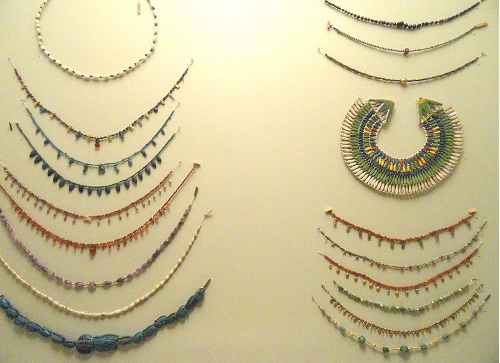
Wealthy Egyptians could afford to buy beautifully crafted pieces of jewellery, but even those who could not afford the works of lesser craftsmen could employ their own ingenuity to make lovely pieces with which to adorn themselves.
In art the upper classes and the gods are almost always shown wearing a significant quantity of jewellery as a mark of their status. This particularly relates to collars and necklaces made from precious metals, as these pieces of jewellery were often given as gifts by pharaoh to loyal supporters, making them a great source of personal pride. In biographies inscribed on the walls of their tombs, successful Egyptians are not slow to boast of every occasion that their king rewarded their actions with a gift of a gold necklace!
Wesekh Collar
Probably the most iconic form of Egyptian jewellery is the broad layered collar known as a “wesekh” (“wasekh”, or “weskhet”). This collar often had a counterpoise which hung down between the shoulder blades which was referred to as “mankhet” (“that which lives”). The collar was composed of cylinders or tubes strung in horizontal rows around a central choker. The collars often have an outer row of leaf-shaped pendants, but sometimes the leaf beads are strung between two rows of horizontal beads.
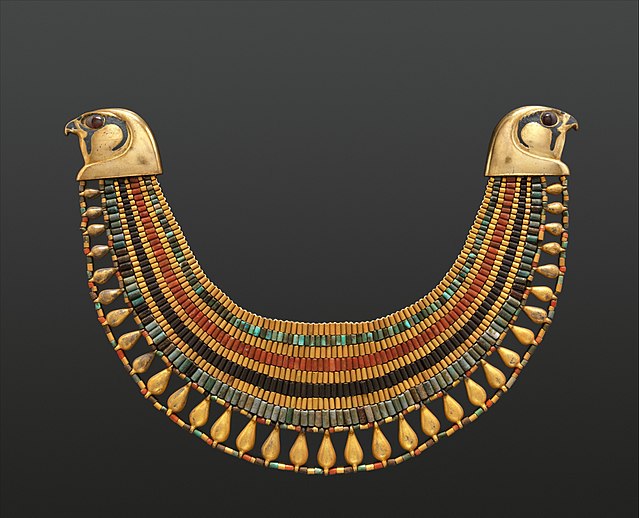

In art, the wesekh collar was favoured by both the gods and the pharaohs. From the Eighteenth Dynasty, this was the form of necklace most often given to officials, dignitaries, and soldiers as a mark of honour.
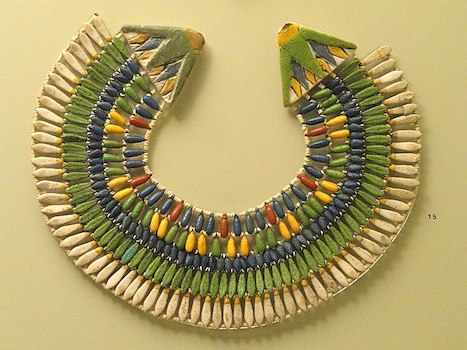
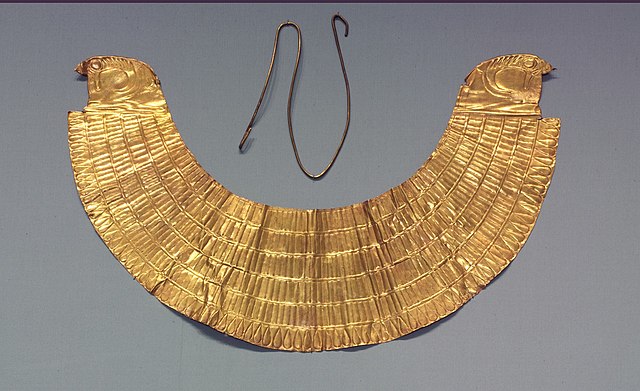
Although the wesekh collar was often made of gold, examples made of other precious metals (such as copper and silver), gemstones (most notably Feldspar, Carnelian, Jasper, Turquoise and Lapis), stone, and faience have also been recovered.
The broad collar was composed of two necklace ends (often in the shape of a falcon head or a representation of a god), numerous strings of beads, and a counterpoise called a “menat”.
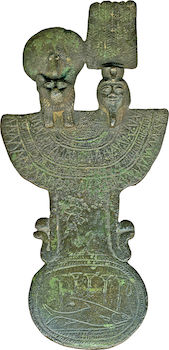

Although the menat could feature other gods, it was most closely associated with the goddess Hathor, often including an inscription to Hathor or an image of the goddess. The Menat was also worn with a less structured groups of stringed of beads (below).


The menat was usually worn by priests and priestesses of Hathor, and was used by female and male dancers along with the Sistrum (also associated with Hathor). It is thought that it was also used as a musical instrument when combined with the sistrum. The earliest examples so far discovered belonged to two priestesses of Hathor who lived during the Old Kingdom.
Shebyu Collar
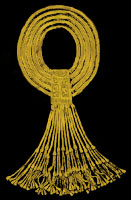
The shebyu (shebu or shebiu) collar was first introduced by Thutmosis IV (New Kingdom). It was often worn by New Kingdom pharaohs but was also given as a reward for valor or distinguished service, especially during the reign of Akhenaten.
The collar consisted of up to five rows of circular biconical beads strung side-by-side and joined by a central clasp. In some cases, there are also a number of thinner strands hanging from the central clasp (such as in the collar of Psusennes, left).
The collars were often formed entirely out of gold, but there are examples of collars incorporating faience (such as one from the tomb of Tutankamun).
Neckalces and amulets
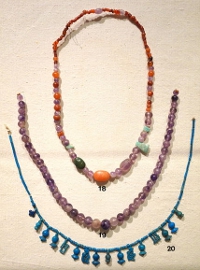
Simple necklaces were often created using tiny beads of lapis, malachite, turquoise, silver, and gold. Beautiful charms featuring powerful amulets such as the Ankh or Eye of Horus or representing one of the gods or goddesses were often added to the design to create more complex pieces.
While the more complex collars required a significant level of skill to produce, the simple stringed necklace was much easier, faster, and cheaper to make. As a result, we may not see these simple necklaces as often in Egyptian art, but there is no doubt that in reality they were very popular.
Necklaces and amulets were also very popular as burial goods. Along with pottery, simple string necklaces form the most common funerary provisions of even very simple burials of both men and women. In some cases only a few beads were interred with the deceased, in other cases even simple graves held numerous beautiful pieces.
Bibliography
- Bard, Kathryn (2008) An introduction to the Archaeology of Ancient Egypt
- Grajetzki, W (2003) Burial Customs in Ancient Egypt
- Kemp, Barry J (1991) Ancient Egypt: Anatomy of a Civilisation
- Trigger, B.G, Kemp, B.J, O’Connor. D, Lloyd. A.B (1983) Ancient Egypt, A Social History/li>
- Wilkinson, Richard H. (2003) The Complete Gods and Goddesses of Ancient Egypt
Copyright J Hill 2014